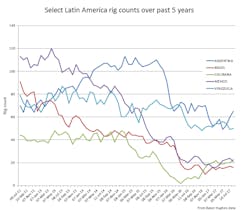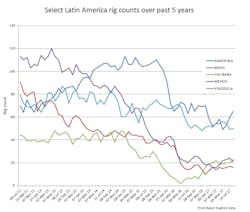Baker Hughes: Canada boosted global rig count in July
The number of active rigs drilling worldwide climbed by 69 month-over-month in July to average 2,041, according to Baker Hughes data. The count was up 629 year-over-year.
Canada provided most of the monthly rise, gaining 48 rigs in July compared with its June average to tally 198, an increase of 104 year-over-year. It marked the second straight month in which Canada led global gains, reflecting a better-than-expected seasonal ramp up in drilling while US rig count growth slowed (OGJ Online, July 10, 2017).
The elevated Canadian count compared with a year ago prompted the Petroleum Services Association of Canada (PSAC) last week to lift its forecast for total wells drilled in the country during the year to 7,200 from 6,680 (OGJ Online, Aug. 2, 2017).
PSAC now estimates 3,604 wells will be drilled during the year in Alberta, up from 1,900 in the original forecast. In British Columbia, it expects 580 wells will be drilled, up 300 from the original forecast.
Mark Salkeld, PSAC president and chief executive officer, explained the rationale for the revision as well as the impetus for the rise in the Canadian rig count.
“One of the events that played out that was not well understood at the time of the original forecast was the relatively quick impact of the transfer of investment out of the oil sands into the conventional sector and, more specifically, towards liquid rich natural gas and light tight oil, which ultimately provide a faster return on investment dollars than the longer-term investment oil sands projects,” Salkeld said.
“This investment shift played an important role in taking a rig count from what we thought would be closer to 200 active rigs to well over 300 in first-quarter 2017,” Salkeld said.
The US rig count was up by just 22 month-over-month in July to 953, an increase of 504 year-over-year. As of the week ended Aug. 4, the US count had fallen in 3 the previous 6 weeks (OGJ Online, Aug. 4, 2017).
Latin America growth continues
Latin America increased 4 units month-over-month in July to reach 196, up 10 year-over-year. Argentina jumped 5 units to 65, down 7 year-over-year. Colombia climbed 3 units to 23, up 17 year-over-year. Venezuela edged up a unit to 50, even with its year-ago average.
Mexico, meanwhile, dropped 3 units during the month to 21, down 2 year-over-year. Brazil declined a unit to 16, up 1 year-over-year.
Africa rose 3 units month-over-month in July to 89, up 7 year-over-year. Algeria edged up a unit to 58, an increase of 3 year-over-year. Nigeria also gained a unit and averaged 9, up 4 year-over-year.
The Asia-Pacific region edged up a unit month-over-month in July to 196, an increase of 9 year-over-year. Offshore China jumped 4 units to 24, down 4 year-over-year. India dropped 2 units to 108, down 5 year-over-year.
The Middle East sat unchanged during July at 397, still up 7 year-over-year. Saudi Arabia’s count averaged 119 for a fifth consecutive month. Iraq gained 2 units to 53, up 14 year-over-year. UAE-Abu Dhabi also rose 2 units and averaged 51, up 3 year-over-year. Egypt fell 4 units to 23, down 4 year-over-year.
Europe dived 9 units month-over-month in July to 82, down 12 year-over-year. Serbia and Montenegro lost all 3 of its active rigs. Norway dropped 2 units to 13, down 7 year-over-year. Italy declined 2 units to 2, half its year-ago average. Offshore UK increased 2 units to 10, even with its year ago average.
Contact Matt Zborowski at [email protected].

